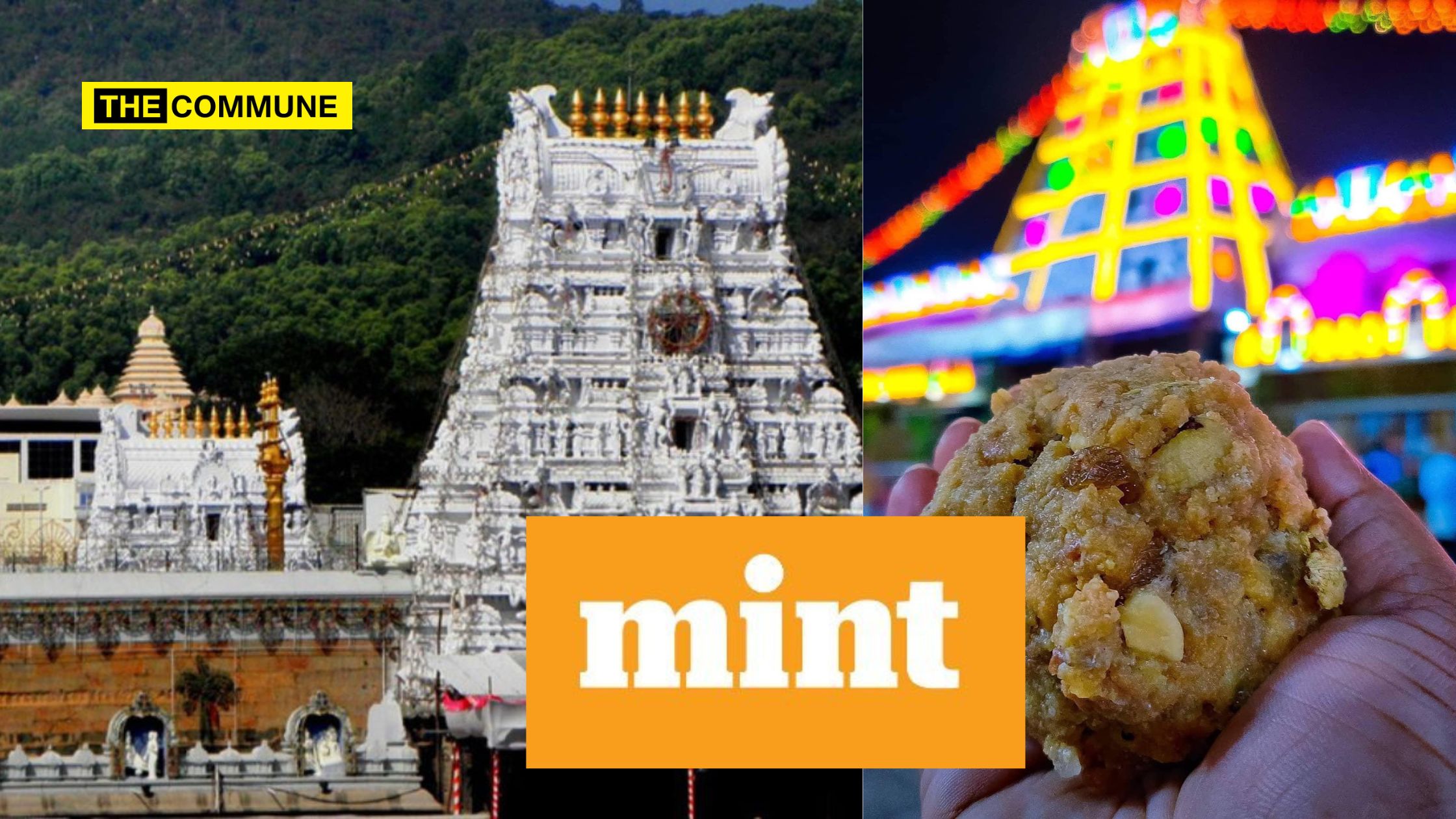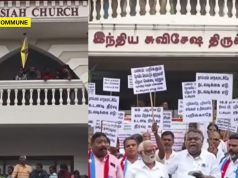
On 28 September 2024, Mint published an op-ed by Nisha Susan, which sparked widespread outrage for its insensitive remarks concerning the Tirupati Laddu controversy. The article was a mere mockery of sentiments and was condemned as condescending and disrespectful to Hindu devotees. Susan also downplayed serious allegations regarding the use of animal fat in the ghee used for the laddus, dismissing it as mere “adulteration.” The article’s offensive tone and careless approach to faith-related concerns raised questions about journalistic standards and ethics, especially when discussing deeply personal matters of religious belief.
The issue with the article was not only about Hindu sentiments but also because Susan’s op-ed referenced a post by author Saiswaroopa Iyer, where she recalled her mother’s health concerns after consuming the famous Tirupati Laddus. While Susan did not explicitly mention Iyer’s name, the op-ed’s tone and content left little doubt about the reference. In her post on 19 September 2024, Iyer shared how her mother had repeatedly fallen sick after consuming the laddus over the past few years. Despite her mother’s warnings about the quality of the laddus, the family had dismissed it as “general paranoia.” Iyer later came to realize that her mother may have sensed something wrong with the laddus, as later allegations of adulteration surfaced.
https://twitter.com/Sai_swaroopa/status/1836770193667707207
In her op-ed, Susan responded to Iyer’s post with a highly insensitive and disrespectful question: “Was Amma dead?” She went on to mock the concerns raised by Iyer’s mother, comparing her instincts to that of a pet animal that acts protectively. Susan’s remarks were belittling not just a mother’s concern, but also the faith and devotion associated with temple offerings like the Tirupati Laddu.
Susan wrote: “I found the post intriguing for its sad, wistful tone. Was Amma dead? Why else would the author write it in this way, the way one would talk about the misunderstood family pet, the horse that refused to cross the damaged bridge, or the dog that barked at the cobra under the woodpile and saved the family’s baby?” The comparison of a mother’s protective instincts to that of an animal, coupled with the insensitive death reference, fueled a wave of criticism on social media.
The reference to Iyer’s mother was not only offensive but also unnecessary. Faith and family are deeply intertwined in religious practices, and questioning a mother’s health in such a manner was seen as crossing the line. Iyer’s post was meant to highlight a genuine concern about the quality of the laddus, but Susan’s remarks turned it into an opportunity for mockery.
When Susan’s op-ed was published, it didn’t take long for the public backlash to erupt. Iyer responded on social media, expressing her dismay at the op-ed. She posted, “How cheap should you have to get to wish death upon a mother @chasingiamb? Shame on you @livemint for publishing that cheap crap.”
Her reaction resonated with many who found Susan’s comments in poor taste.
How cheap should you have to get to wish death upon a mother @chasingiamb ?
Shame on you @livemint for publishing that cheap crap— Saiswaroopa Iyer (@Sai_swaroopa) September 28, 2024
The wave of backlash highlighted a broader issue—how such inflammatory and hurtful content could pass through a reputed publication’s editorial filters. It only proved that “journalists” like Nisha Susan harboured hate towards Hindus and Mint failed to exercise adequate editorial oversight.
Susan’s dismissal of the animal fat controversy in the Tirupati Laddu also sparked anger. Allegations about the adulteration of ghee used in the laddus had surfaced after Andhra Pradesh’s Chief Minister Chandrababu Naidu raised the issue. Laboratory tests conducted by the National Dairy Development Board’s CALF (Centre of Analysis and Learning in Livestock and Food) laboratory confirmed the presence of tallow (beef fat), lard (pig fat), and fish oil in the ghee, along with several types of vegetable oils. The findings were significant, given the spiritual importance of the Tirupati Laddu to millions of Hindu devotees.
However, Susan downplayed these findings, suggesting the controversy was blown out of proportion due to the notion that the laddus contained animal fat. She claimed that the ghee was adulterated primarily with vegetable oils like soybean and sunflower oil. This assertion ran counter to the laboratory findings, which confirmed the presence of animal fats, and her attempt to minimize the issue was seen as dismissive of the religious and cultural significance of the prasad.
Susan’s op-ed also took another dig at Iyer by ridiculing the social media traction her original post gained. Several other accounts had plagiarized Iyer’s post, and Susan sarcastically referred to it as the “one nation, one Amma, one Laddu scheme.” The comment further alienated readers who viewed it as an unnecessary mockery of a serious issue.
https://twitter.com/Sai_swaroopa/status/1837096041033675184
NCW Complaint
Saiswaroopa Iyer filed a complaint with the National Commission for Women about the article.
https://twitter.com/Sai_swaroopa/status/1840367080354250990
She followed it up with a note of grievance to LiveMint Editor Ravi Krishnan as well.
https://twitter.com/Sai_swaroopa/status/1840369042235834370
Mint Response
LiveMint responded with a 3-sentence reply to the complaint made by Saiswaroopa. In the cheeky response that had no apology, they wrote,
“We’d just like to point out, as you yourself have stated in your email, that multiple user accounts shared this very same quote. The reference was made in a completely generic sense and there was no intention at all to cause any distress or hurt your sentiments or faith in any manner whatsoever. Nevertheless, to respect your concerns, we have amended the article and rewritten that section, without prejudice. We appreciate your understanding.”
The response from @livemint editorial team.
Took me sometime to digest the brazenness with no apology https://t.co/hlcL9D95d8 pic.twitter.com/Q9QahA4Ena— Saiswaroopa Iyer (@Sai_swaroopa) September 30, 2024
The handling of Nisha Susan’s op-ed by Mint, from its initial publication to its inadequate response, reflects a serious lapse in journalistic integrity and editorial oversight. The article’s blatant disregard for Hindu sentiments, coupled with its condescending mockery of personal and religious concerns, demonstrated a profound disrespect for its readership. However, the publication’s unapologetic stance in the face of legitimate grievances was more troubling. Despite the public outcry and Saiswaroopa Iyer’s formal complaint, Mint’s response was dismissive, offering no real accountability or remorse. The callous reply from LiveMint failed to address the seriousness of Susan’s offensive remarks and belittled the concerns of not just one individual but an entire community of devotees. The editor, Ravi Krishnan, and his team’s unwillingness to take meaningful corrective action or issue a sincere apology raises questions about the publication’s ethical standards and commitment to responsible journalism.
(With inputs from OpIndia)
Subscribe to our Telegram, WhatsApp, and Instagram channels and get the best stories of the day delivered to you personally.




